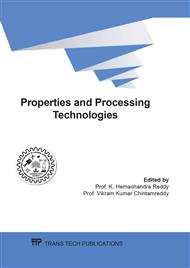[1]
E.W. Wong, P.E. Sheehan, C.M. Liebert Nanobeam mechanics: elasticity, strength, and toughness of nanorods and nanotubes,, Science277(1997) 1971–(1975).
DOI: 10.1126/science.277.5334.1971
Google Scholar
[2]
S.Iijima, Helical microtubules of graphitic carbon,, Nature354(1991)56–58.
Google Scholar
[3]
J. Hashim, The Production of Cast Metal Matrix Composite by a Modified Stir Casting Method, Jurnal Teknologi, 35(A) Dis. (2001), pp.9-20.
DOI: 10.11113/jt.v35.588
Google Scholar
[4]
W. H. Hunt and D. R. Herling, Aluminum Metal Matrix composites,, Adv. Mat.s & Proc., February (2004), pp.39-42.
Google Scholar
[5]
Kang, C.G., Bae J.W., Kim, B.M., 2007. The grain size control of A356 aluminum alloy by horizontal electromagnetic stirring for rheology forging. Journal of Materials Processing Technology 187–188, 344–348.
DOI: 10.1016/j.jmatprotec.2006.11.181
Google Scholar
[6]
Cao. G, Kobliska. J, Konishi. H and Li. X. 2008.Tensile Properties and Microstructure of SiC Nanoparticle–Reinforced Mg-4Zn Alloy Fabricated by ultrasonic Cavitation–Based Solidification Processing. Metallurgical and Materials Transactions A, pp.880-886, Vol. 39A.
DOI: 10.1007/s11661-007-9453-6
Google Scholar
[7]
Ali Sangghaleh, Mohammad Halali. Effect of magnesium addition on the wetting of alumina by aluminum, Elsevier, Applied Surface Science 255 (2009) 8202–8206.
DOI: 10.1016/j.apsusc.2009.05.044
Google Scholar
[8]
S. R. Bakshi, D. Lahiri, and A. Agarwal. Carbon nanotube reinforced metal matrix composites- a review, International Materials Reviews, 2010, VOL 55 NO 1.
DOI: 10.1179/095066009x12572530170543
Google Scholar
[9]
Abedi, K., Emamy, M., 2010. The effect of Fe, Mn, and Sr on the microstructure and tensile properties of A356–10% SiC composite. Materials Science and Engineering: A 527 (16–17), 3733–3740.
DOI: 10.1016/j.msea.2010.03.063
Google Scholar
[10]
Hansang Kwon and Marc Leparoux (2012), Hot extruded carbon nanotube reinforced aluminum matrix composite materials, vol.23, pp.415-425.
DOI: 10.1088/0957-4484/23/41/415701
Google Scholar
[11]
Poovazhagan.La, Kalaichelvan.Ka, Rajadurai.Aa and Senthilvelan.V b, Characterization of Hybrid Silicon Carbide and Boron Carbide Nanoparticles-Reinforced Aluminum Alloy Composites, Procedia Engineering 64 (2013) 681 – 689.
DOI: 10.1016/j.proeng.2013.09.143
Google Scholar
[12]
A.M. Al-Qutub, A.Khalil, N.Saheb, A.S. Hakeem, Wear and friction behavior of Al6061 alloy reinforced with carbon nanotubes, Wear 297 (2013) 752–761.
DOI: 10.1016/j.wear.2012.10.006
Google Scholar
[13]
Kaushik B.K and Majumder M.K. 2015. Carbon Nanotube: Properties and Applications. Carbon Nanotube-Based VLSI Interconnects, Springer Briefs in Applied Sciences and Technology. IX, p.86.
DOI: 10.1007/978-81-322-2047-3_2
Google Scholar
[14]
Moses J J, Dinaharan I, and Sekhar S J 2016 Prediction of influence of process parameters on tensile strength of AA6061 / TiC aluminum matrix composites produced using stir casting Trans. Nonferrous Met. Soc. China 26 1498–1511.
DOI: 10.1016/s1003-6326(16)64256-5
Google Scholar
[15]
Rajesh N, Yohan M, Fabrication and Mechanical properties of aluminum metal matrix nanocomposite (Al6061/CNT). ARPN Journal of Engineering and Applied Sciences. vol. 13, no. 23, December 2018, ISSN 1819-6608, pp.9061-9064.
Google Scholar
[16]
B. Madhusudhana Reddy, Anand P (2019). Exploration of Special Properties of AL 5056/CNT Metal Matrix Nano-Composites. International Journal of Recent Technology and Engineering, vol. 8, Iss. 2, pp.2829-2833.
DOI: 10.1016/j.matpr.2019.07.399
Google Scholar


